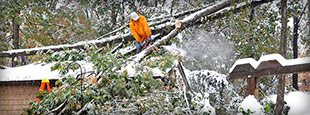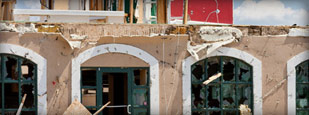- Home
- Who Are You?
- Residential
- • Homeowners
- • Condominium Owner
- • Tenant/Renter
- • Co-op Owner
- • Vacation / 2nd Home Owner
- Commercial / Industrial
- • Business Owner
- • Property Owner
- • Property Manager
- • Condominium Association
- • Cooperative
- • Municipality
- • Institutions
- - Churches / Synagogues
- - Schools
- Attorneys / Consultants
- • Attorney
- • Consultant
- • Accountant
- • Financial Advisor
- • Property Manager
- • Risk Manager>
- • Broker
- • Business Advisor
- • Realtor
- • Administrator
- Residential
- Services
- About Us
- Reviews/Testimonials
- In the News
- Hot off the Press
- Contact Us



In the News
Home Economics: Now comes the hard work – including insurance adjusting
November 03, 2012 | By Alan J. Heavens, Inquirer Staff Writer
The telephone began ringing nonstop in public insurance adjuster Ira Straff's Bala Cynwyd office Monday afternoon, even as Hurricane Sandy was spinning off the New Jersey coast, looking for a place to land.
On Thursday afternoon, Straff, president of the Insurance Adjustment Bureau, a 48-year-old firm that represents property owners in negotiating claims settlements with insurance companies, was in his office, having spent the last three days “walking through muck” all over the region.
“This is the largest storm I've ever seen hit the Northeast in my career,” he said. “I was in Katrina, and in hurricanes in Florida, but this one was worse because it hit so many more states. The effects have been massive.”
As will the task of repairing all the damage, once the insurance issues have been sorted out.
“When the calls started Monday, trees already were falling on buildings, shingles were flying off roofs, and chimneys were collapsing,” he said.
“A big problem has been contacting our clients' insurance agents and brokers, especially those in northern New Jersey,” where offices have been flooded and phone and electrical service interrupted, Straff said.
Basically, insurers must be notified immediately – actual time limits are specified in policies – once Straff or adjusters like him survey damaged properties and before estimates of damage can be made.
“Remember that an insurance policy is a contract between you and the insurer, and has terms and conditions that both sides must meet,” Straff said.
Most people don't have any idea what their homeowners policies cover, “assuming they cover everything, and never expecting they would ever have to make a claim,” he said. “If the insurers would take the time to explain things clearly, life would be easier.”
In addition, after years of economic struggle, many property owners have opted for higher deductibles and the lowest homeowners insurance coverage their mortgage lender will allow.
New Jersey homeowners have hurricane deductibles of 1 percent to 3 percent, too, unless they have opted to pay a higher premium for more coverage.
There's a lot of fine print.
“We inspect and review the policy to be sure of what is covered, and then we assemble a damage estimate based on coverage and the extent of loss, the damage to possessions, as well as temporary-relocation assistance.”
If you thought “temporary relocations” due to Sandy were limited to the Shore, you'd be wrong. On Wednesday, Straff was in Easton, where the wind had lifted the roof off a 36-unit apartment house and “the rain came in,” he said. “All the tenants had to be relocated.”
Matthew Dishner, who handles business development in central Pennsylvania for Mellon Certified Restoration in Yeadon, said one of his colleagues was spending Thursday in Nesquehoning, Carbon County, where wind had blown off the roof of a conference center at KEM Kovatch Corp., which manufactures custom fire apparatus.
Dishner, who is based in Mellon's Harrisburg office, said the damage would likely exceed a couple hundred thousand dollars.
“They said the wind in Allentown reached 91 miles an hour,” said Dishner, whose employer handles residential and commercial restorations for the major insurance companies.
“When wind blows rain that hard sideways, the water will find the path of least resistance,” he said. “We've been getting a lot of calls for first-time losses from roof leaks and around doors and windows. It has never happened before and may likely not happen again.”
Unlike Straff and other public adjusters, who deal with the insurance companies on behalf of property owners, Mellon's first question to a caller with damage is: “Have you contacted your agent?” Dishner said. If the answer is yes, Mellon – which works for the insurance companies – can dispatch a crew to assess damage.
“We go out as soon as we can,” he said, “but how fast we respond depends on the number of claims we receive. As soon as the crews come back, however, we send them out again.”
“Often, we work through the night,” Dishner said, removing smaller trees but hiring an expert familiar with taking care of more mature ones to clear the building.
“Once that's done, we put a tarp over the roof to secure the area, and begin assessing the damage and start repairs – especially areas where water has intruded,” he said.
Water damage needs to be tackled quickly to deter formation and spread of mold – claims for which, Straff said, most insurers now limit or require special coverage for.
“Sometimes, we only have to open the walls a little bit to let the interiors dry,” Dishner said. “Many times, all drywall comes off, as well as the insulation, so we can let the wall studs dry out completely.”
Although both men reported a lot of wind damage and fallen trees throughout the region, Straff said that how a storm affects an area is not at all predictable.
“It's obvious that flooding because of storm surge was the problem at the Shore,” he said. “Last year, during Hurricane Irene, one-and-a-half inches of rain fell in an hour and caused flooding in Manayunk, but this time, it didn't happen.”
What is happening already is repair-scamming.
“There are always people who prey on individuals in time of need,” Straff said. “Most people have all their money tied up in a very valuable asset. It is important to understand how they can protect their investment.”
“I wish to express my deepest gratitude to you and your staff for the splendid job you did for me regarding my fire insurance claim. The proceeds will allow me to restore my property damage adequately.
The same building caught fire about a year ago and it damaged my property then, too. However, the insurance company’s agent did not represent my rights. Consequently, I had to pay out money as a result of the fire.
The expertise of your employees is really the best way to deal with these problems. Your services will always be deeply appreciated.”
– Flora L.
Business Owner
Philadelphia, PA
